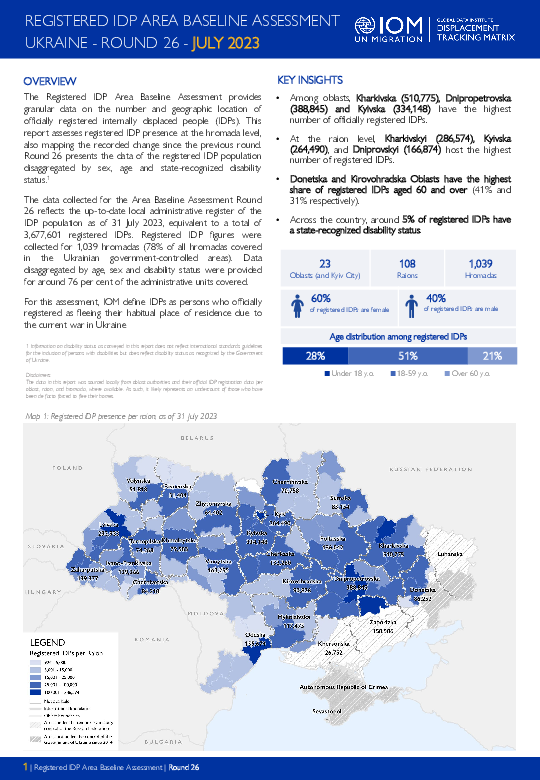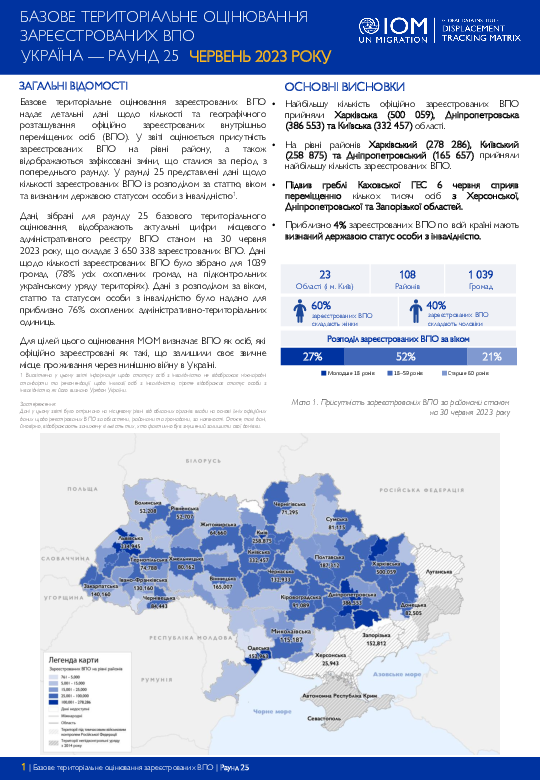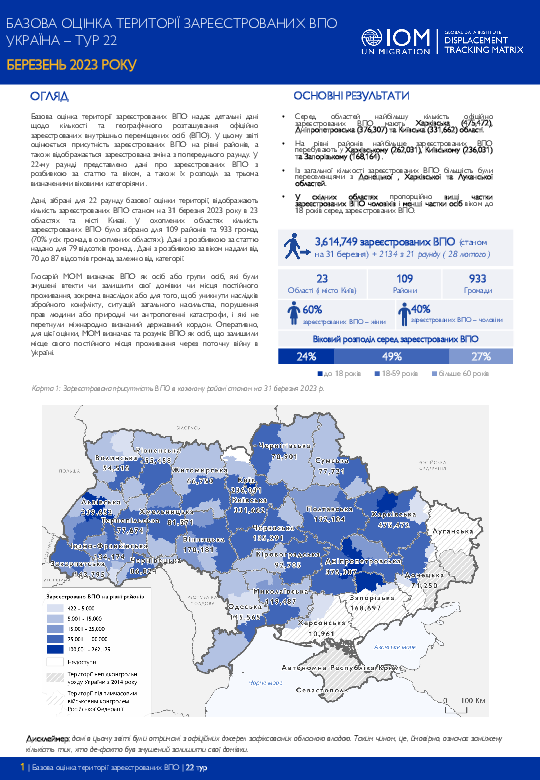-
Countries
-
Data and Analysis
-
Special Focus
-
Crisis Responses
Ukraine
Error message
The submitted value field_published_date_value in the Sort by element is not allowed.
IDPs Population
Displacement Movements
3,689,000
IDMC 2023
Data collection round
About Ukraine
In Ukraine, IOM implements diverse elements of the Displacement Tracking Matrix (DTM) toolbox as part of a broader Data and Analytics programme. The chief aim of IOM’s data gathering in the country is to monitor population displacement and mobility as well as priority needs and key conditions to support IOM and partners’ programming and facilitate an evidence-based response. IOM collects data through a variety of complementary approaches at the national, macro-regional, and local level, relying on an established network of data collection experts in the field, a network of key informants (KIs) across all regions (oblasts), as well as on randomized sampling in nation-wide phone surveys. DTM assessments gather and disseminate data not only on the flow and size of the population experiencing displacement (IDPs and returnees) but also on a range of thematic issues characterizing the humanitarian and recovery needs and context in locations where internally displace people (IDPs), returnees and vulnerable conflict-affected populations are present.
Beyond data production, IOM’s data and analytics portfolio in Ukraine includes convening humanitarian and recovery stakeholders on issues related to data coordination and implementation of standards in data collection, seeking to support data actors in harmonization of approaches, cross-validation, and joint analysis of existing evidence, and lessening the survey burden on vulnerable populations. Furthermore, IOM works closely with government stakeholders to support Ukrainian counterparts across local, regional and national governmental bodies to independently implement data collection and analysis and in effectively utilizing data for evidence-based response and policy-making.
Current Donors
- Belgium
- Canada
- France
- Germany
- European Union
- South Korea
- United Kingdom
- United States
- Norway
- Czech
УКРАЇНА — МЕТОДОЛОГІЧНА ЗАПИСКА — ОПИТУВАННЯ ЗАГАЛЬНОГО НАСЕЛЕННЯ УКРАЇНА
24 лютого 2022 року Російська Федерація (РФ) розпочала повномасштабне вторгнення в Україну, що спричинило безпрецедентну гуманітарну кризу по всій Україні.
Ukraine — Area Baseline Assessment (Raion level) — Round 26 (July 2023)
The Registered IDP Area Baseline Assessment provides granular data on the number and geographic location of officially registered internally displaced people (IDPs). This report assesses registered IDP presence at the hromada level, also mapping the recorded change since the previous round.
УКРАЇНА — ЗВІТ ПРО ПОВЕРНЕННЯ В УКРАЇНІ - ОПИТУВАННЯ ЗАГАЛЬНОГО НАСЕЛЕННЯ 13 (11 ТРАВНЯ - 14 ЧЕРВНЯ 2023)
Після 24 лютого 2022 року повномасштабне вторгнення Російської Федерації (РФ) в Україну спричинило безпрецедентну гуманітарну кризу по всій країні.
Ukraine — Methodological Note — General Population Survey
Starting on 24 February 2022, the Russian Federation (RF) launched a large-scale invasion of Ukraine, triggering an unprecedented humanitarian crisis across Ukraine.
DTM Ukraine — Oblast Profiles — General Population Survey, Round 13 (June 2023)
The Oblast profiles are based on the IOM General Population Survey Round 13 dataset, a highly representative assessment with over 20,000 random respondents interviewed nationwide.
Україна - Звіт про ситуацію з внутрішнім переміщенням - Загальне опитування населення Раунд 13 (11 травня - 14 червня 2023 року)
Після 24 лютого 2022 року повномасштабне вторгнення Російської Федерації (РФ) в Україну спричинило безпрецедентну гуманітарну кризу по всій країні.
Україна - Оцінка базового рівня території (районний рівень) - 25 раунд (червень 2023 року)
Дані, зібрані для раунду 25 базового територіального оцінювання, відображають актуальні цифри місцевого адміністративного реєстру ВПО станом на 30 червня 2023 року, що складає 3 650 338 зареєстрованих ВПО.
Ukraine — Conditions of Return Assessment Factsheet — Round 3 (June 2023)
This factsheet provides an overview of data from Round 3 of the Conditions of Return Assessment (CoRA), which was conducted in May and June 2023 in 51 hromadas across 14 oblasts.
Ukraine — Returns Report — General Population Survey Round 13 (June 2023)
To support partners in providing targeted and evidence-based assistance to the most vulnerable among those who have returned to their areas of habitual residence after a period of forced displacement, the Data and Analytics team of IOM Ukraine is pleased to present th
Ukraine — Area Baseline Assessment (Raion level) — Round 25 (June 2023)
The Registered IDP Area Baseline Assessment provides granular data on the number and geographic location of officially registered internally displaced people (IDPs).
Ukraine — Internal Displacement Report — General Population Survey Round 13 (11 May - 14 June 2023)
Between 11 May and 14 June 2023, the International Organization for Migration (IOM) conducted the 13th round of a highly representative assessment of the general population in Ukraine to gather information on displacement, mobility flows, intentions, and conditions to inform targeted assistance t
ОЦІНКА УМОВ ПОВЕРНЕННЯ, ІНФОРМАЦІЙНИЙ БЮЛЕТЕНЬ, РАУНДУ 2 (КВІТЕНЬ 2023 РОКУ)
Станом на травень 2023 року в статусі внутрішньо переміщених осіб залишається орієнтовно 5 088 000 людей, а за кордон виїхало орієнтовно 8 255 000 осіб.
Ukraine — Area Baseline Assessment (Raion level) — Round 24 (May 2023)
The Registered IDP Area Baseline Assessment provides granular data on the number and geographic location of officially registered internally displaced people (IDPs).
ОПЕРАТИВНИЙ ЗВІТ: ДЕМОГРАФІЧНА СТАТИСТИКА ТА ГЕОГРАФІЧНИЙ РОЗПОДІЛ — ОПИТУВАННЯ ЗАГАЛЬНОГО НАСЕЛЕННЯ, РАУНД 13 (11–23 травня 2023 року)
З березня 2022 року, після повномасштабного вторгнення збройних сил Російської Федерації в Україну, Міжнародна організація з міграції (МОМ) збирає інформацію про місцезнаходження, демографію, становище, потреби та наміри щодо мобільності внутрішньо переміщених осіб (ВПО), осіб, що повернулися, та
Ukraine — Snapshot report: Population Figures and Geographic Distribution — General Population Survey Round 13 (11 - 23 May)
Since March 2022, following the full-scale invasion of Ukraine by the Armed Forces of the Russian Federation, the International Organization for Migration (IOM) has been collecting information on the location, demographics, situation, needs and mobility intentions of internally displaced people (
Ukraine — Conditions of Return Assessment Factsheet — Round 2 (March - April 2023)
The Conditions of Return Assessment is a multi-sectoral location-level assessment (MSLA) conducted with local authority key informants at the settlement or city-raion level in areas of return across Ukraine.
Україна — Базове Територіальне Оцінювання Зареєстрованих ВПО (районний рівень) — Раунд 23 (April 2023)
Базове територіальне оцінювання зареєстрованих ВПО надає детальні дані щодо кількості та географічного розташування офіційно зареєстрованих внутрішньо переміщених осіб (ВПО).
Ukraine — Area Baseline Assessment (Raion level) — Round 23 (April 2023)
The Registered IDP Area Baseline Assessment provides granular data on the number and geographic location of officially registered internally displaced persons (IDPs). This report assesses registered IDP presence at the raion level, also mapping the recorded change since the previous round.
Україна - Оцінка базового рівня території (районний рівень) - 22 раунд (березень 2023 року)
Базова оцінка території зареєстрованих ВПО надає детальні дані щодо кількості та географічного розташування офіційно зареєстрованих внутрішньо переміщених осіб (ВПО).
Ukraine — Area Baseline Assessment (Raion level) — Round 22 (March 2023)
The Registered IDP Area Baseline Assessment provides granular data on the number and geographic location of officially registered internally displaced persons (IDPs). This report assesses registered IDP presence at the raion level, also mapping the recorded change since the previous round.
УКРАЇНА — БАЗОВА ОЦІНКА ТЕРИТОРІЇ ЗАРЕЄСТРОВАНИХ ВПО ПІДСУМКИ 21 ТУРУ
Базова оцінка території зареєстрованих ВПО надає детальні дані щодо кількості та географічного розташування офіційно зареєстрованих внутрішньо переміщених осіб (ВПО). Збір даних для 21-го туру базової оцінки території відбувався з 1 по 28 Лютого 2023 року в 23 областях та місті Києві.
Mapping the Situation and Needs of Displaced People in Zakarpatska Oblast (9 - 27 Nov 2022)
In response to a request from the Zakarpatska Oblast Military Administration (ZOMA), IOM conducted a household survey to gather data on the situation, needs and future intentions of internally displaced persons (IDPs) currently residing in Zakarpatska oblast in the west of Ukraine.
Україна —Інформаційний бюлетень щодо оцінки умов повернення — раунд 1 (січень – лютий 2023 року)
Оцінка умов повернення – це багатогалузева оцінка на місцевому рівні (МБОМ), яку проводять за участю ключових інформантів місцевої влади на рівні населеного пункту або району міста в місцях повернення по всій Україні.
Ukraine — Area Baseline Assessment (Raion level) — Round 21
The Registered IDP Area Baseline Assessment provides granular data on the number and geographic location of officially registered internally displaced persons (IDPs).
Pagination
Ukraine — Area Baseline Assessment (Raion level) — Round 9
2022-08-05
A baseline assessment is a sub-component of mobility tracking. It aims to collect data on IDP, migrant or returnee population presence in a defined administrative area of the country.
Ukraine — Area Baseline Assessment (Hromada level) — Round 8
2022-07-24
<p>A baseline assessment is a sub-component of mobility tracking. It aims to collect data on IDP, migrant or returnee population presence in a defined administrative area of the country.</p>
Ukraine — Area Baseline Assessment (Raion level) — Round 8
2022-07-24
A baseline assessment is a sub-component of mobility tracking. It aims to collect data on IDP, migrant or returnee population presence in a defined administrative area of the country.
Ukraine — Area Baseline Assessment (Raion level) — Round 7
2022-07-08
A baseline assessment is a sub-component of mobility tracking. It aims to collect data on IDP, migrant or returnee population presence in a defined administrative area of the country.
Ukraine — Area Baseline Assessment (Hromada level) — Round 7
2022-07-08
<p>A baseline assessment is a sub-component of mobility tracking. It aims to collect data on IDP, migrant or returnee population presence in a defined administrative area of the country.</p>
Ukraine — Area Baseline Assessment (Hromada level) — Round 6
2022-06-26
<p>A baseline assessment is a sub-component of mobility tracking. It aims to collect data on IDP, migrant or returnee population presence in a defined administrative area of the country.</p>
Ukraine — Area Baseline Assessment (Raion level) — Round 6
2022-06-26
A baseline assessment is a sub-component of mobility tracking. It aims to collect data on IDP, migrant or returnee population presence in a defined administrative area of the country.
Ukraine — Area Baseline Assessment (Raion level) — Round 5
2022-06-11
A baseline assessment is a sub-component of mobility tracking. It aims to collect data on IDP, migrant or returnee population presence in a defined administrative area of the country.
Ukraine — Baseline Area Assessment (Hromada level) — Round 5
2022-06-10
<p>A baseline assessment is a sub-component of mobility tracking. It aims to collect data on IDP, migrant or returnee population presence in a defined administrative area of the country.</p>
Ukraine — Area Baseline Assessment (Hromada level) — Round 4
2022-05-31
<p>A baseline assessment is a sub-component of mobility tracking. It aims to collect data on IDP, migrant or returnee population presence in a defined administrative area of the country.</p>
Ukraine — Area Baseline Assessment (Raion level) — Round 4
2022-05-31
A baseline assessment is a sub-component of mobility tracking. It aims to collect data on IDP, migrant or returnee population presence in a defined administrative area of the country.

























